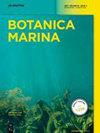加那利群岛、东大西洋最南端黑角藻种群的干燥性和耐热性
IF 1.4
4区 生物学
Q2 MARINE & FRESHWATER BIOLOGY
引用次数: 0
摘要
摘要居住在物种分布外围的种群承受着环境变化的直接压力。在气候变化的背景下,研究它们在压力条件下的生理学至关重要。我们在特内里费岛(加那利群岛)的两个地方(北部和南部),即该物种的南部分布极限,通过测量大型藻类Fucus guiryi的铊的长度、厚度和宽度,表征了两种形态类型。我们假设,来自北方的个体,尤其是大型形态的个体,比来自南方的个体更容易受到干燥和高温的影响。通过两次长时间干燥实验并通过比较营养叶片和生殖叶片来测试对干燥的耐受性。通过将个体在海水(26-32°C)中保持24小时来测试其对高温的耐受性。通过PSII的最大光化学效率来估计应激条件后生理功能的恢复。结果表明,两种形态分化的形态类型都能耐受长时间的干燥;然而,小型企业受到的影响更大,尤其是在北部地区。生殖叶片几乎不受影响,表明其对干燥的耐受性高于营养叶片。岩藻对高温(32°C)表现出耐受性,这表明其对未来变暖情景具有可塑性。本文章由计算机程序翻译,如有差异,请以英文原文为准。
Desiccation and thermo-tolerance of Fucus guiryi (Phaeophyceae) from its southernmost populations (Canary Islands, Eastern Atlantic)
Abstract Populations inhabiting the periphery of a species’ distribution suffer the immediate pressure of the environmental changes. Studying their physiology under stressful conditions is essential in the context of climate change. We characterized two morphotypes with measurements of length, thickness and width of the thallus of the macroalga Fucus guiryi in two localities (north and south) in Tenerife (Canary Islands), the southern limit of distribution of the species. We hypothesized that the individuals from the north locality, especially the large morphotype, would be more vulnerable to desiccation and high temperatures than those from the south. Tolerance to desiccation was tested through two long desiccation experiments and by comparing the vegetative and reproductive blades. Tolerance to high temperatures was tested by keeping the individuals in seawater (26–32 °C) for 24 h. The recovery of physiological functions after the stressful conditions was estimated through maximal photochemical efficiency of PSII. Results indicate that both of the two morphometrically differentiated morphotypes were tolerant to prolonged desiccation; however, the small one was more affected, particularly in the northern locality. The reproductive blades were hardly affected, indicating greater tolerance to desiccation than the vegetative blades. Fucus guiryi showed tolerance to high temperatures (32 °C) suggesting plasticity to future warming scenarios.
求助全文
通过发布文献求助,成功后即可免费获取论文全文。
去求助
来源期刊

Botanica Marina
生物-海洋与淡水生物学
CiteScore
4.10
自引率
4.50%
发文量
43
期刊介绍:
Botanica Marina publishes high-quality contributions from all of the disciplines of marine botany at all levels of biological organisation from subcellular to ecosystem: chemistry and applications, genomics, physiology and ecology, phylogeny and biogeography. Research involving global or interdisciplinary interest is especially welcome. Applied science papers are appreciated, particularly when they illustrate the application of emerging conceptual issues or promote developing technologies. The journal invites state-of-the art reviews dealing with recent developments in marine botany.
 求助内容:
求助内容: 应助结果提醒方式:
应助结果提醒方式:


